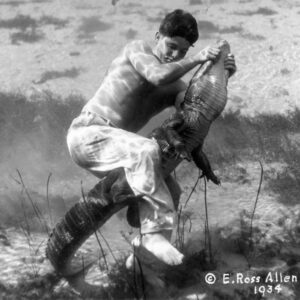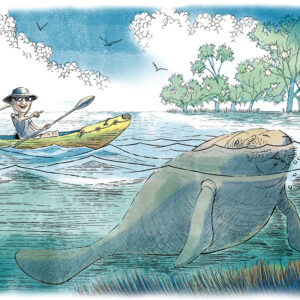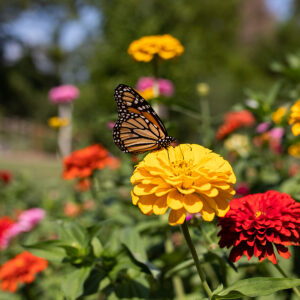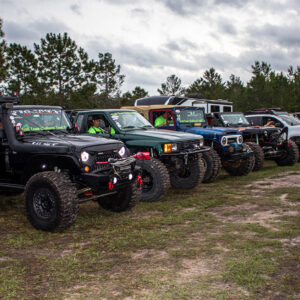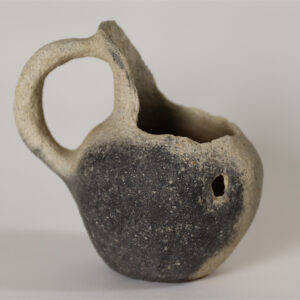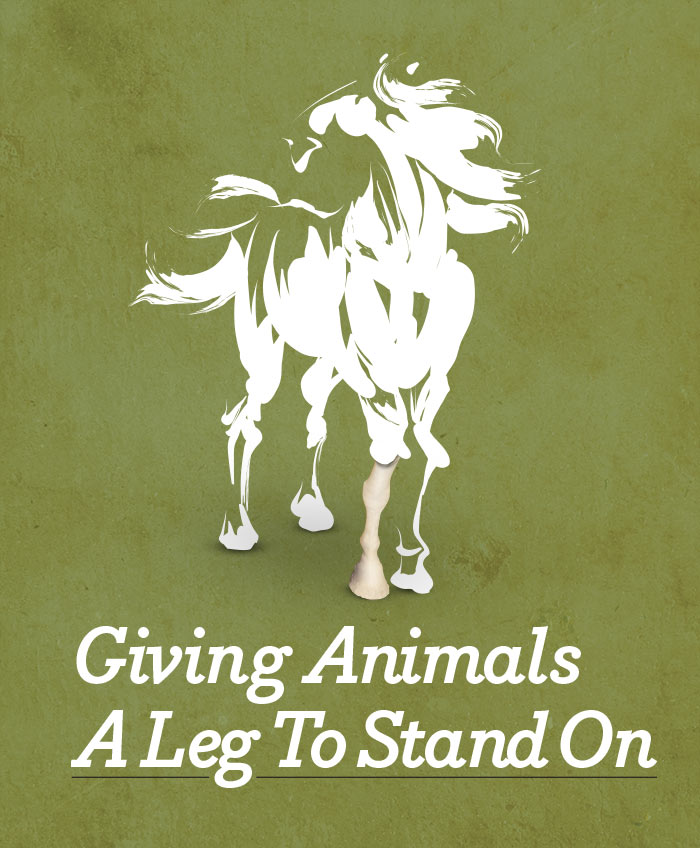
THE FIRST SIGN THAT RONNIE GRAVES ISN’T YOUR ORDINARY GUY IS THE RING FINGER ON HIS LEFT HAND, WHICH IS MISSING THE TOP PORTION. AT 18 MONTHS OF AGE, HE ACCIDENTALLY CUT IT OFF WHILE TRYING TO GET FRUIT COCKTAIL OUT OF A CAN. HIS MOTHER WILL TELL YOU THE TODDLER DIDN’T EVEN BAWL.
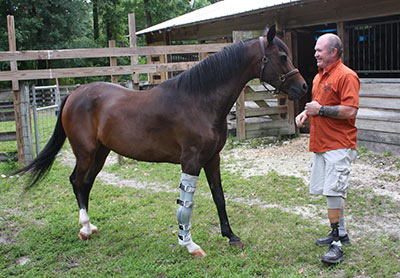
Born in San Diego in 1955, as a young man, Graves never imagined he’d be making artificial legs for horses.
Of course, he never believed he’d lose his own leg either.
On May 15, 1975, the direction of his life took a dramatic turn. Graves, who was just 20 at the time, was working at an organic fertilizer plant in Council Bluffs, Iowa.
He and several other employees were moving four railroad cars, heavily loaded with fertilizer. As instructed, Graves was using a Bobcat skid loader to push a car when a chain snapped. Realizing that one of his co-workers was in danger, Graves leaped off the Bobcat and jumped between the two cars to set the brake.
To this day, he isn’t sure if he slipped or if the car actually knocked him down, but he fell. His left leg was extended across the track and one of the railroad car wheels ran over his foot, pinning it to the track.
Afraid of worse injury from the remaining wheels, Graves grabbed the pinned leg and pulled himself free, tearing loose the lower part of his leg. He immediately took off his belt and applied it as a tourniquet to slow the bleeding.
An ambulance arrived quickly and transported Graves to the hospital, but doctors were unable to reattach his severed lower leg. Eleven days after the accident, he walked out of the hospital on crutches and an artificial leg.
After recovering from the amputation, Graves began driving trucks with his father. The duo owned five trucks together and stayed busy until the truck strike of 1979; the family lost all five trucks and two homes.
That same year the Graves family left Iowa and relocated to North Central Florida. Graves, then 24, started driving a truck for a Leesburg company that moved mobile homes. Struggling to pay his bills and pay for a new prosthetic leg (under Iowa workman’s comp laws, he was responsible for all but the first one), Graves paid a visit to the Florida Department of Vocational Rehabilitation.
“They agreed to buy me a new artificial leg if I would take mechanical and career aptitude tests and an IQ test,” says Graves.
“Those tests indicated I should be doing something in the field of medicine and using my hands. I’ll never forget Mrs. Brockington. She was an elderly African-American woman who worked for the state. She told me I was a whole lot smarter than a truck driver and that prosthetics would be a perfect career choice for me. She got me my first job at Orlando Prosthetics Laboratory in the fall of 1979.”
Graves went on to work at several prosthetics companies before starting his own 10 years later.
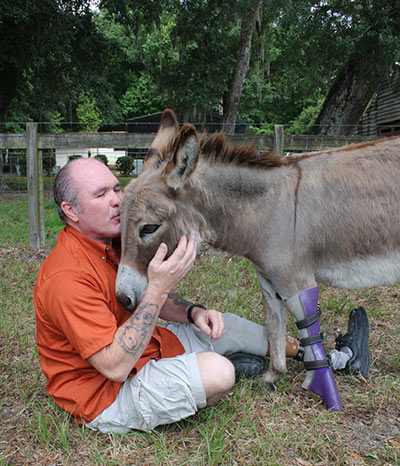
A New Direction
After launching Prosthetics Research Specialists, Inc, in 1989, Graves’ focus was, predictably, on human amputees. He became a Florida Licensed Orthotist and Prosthetist and is also an ABC Certified Technician in Prosthetics. (Prosthetics are for missing parts, while orthotics are for injured parts. Prosthetics replace an extremity or body part, while orthotics—think brace—provide structural support for a body part.)
Although he and his wife, Linda, whom he married in 1982, were both passionate animal lovers, it never occurred to Graves to work on prosthetics for non-human clients. That is, not until 1997 when a horse owner begged him to help her beloved mare who had suffered a devastating knee injury.
“Scarlet had an injury that destroyed the tendons and ligaments around her knee. She was basically living in a sling,” says Graves. “Three vets had told the owner to put the horse down, but Scarlet still had a zest for life. You could see it in her eyes. I didn’t know how to charge for something like this, so I just figured out my exact cost in materials for making a brace and had the owner donate that amount to the local Humane Society.”
The brace gave Scarlet the support she needed to heal; she wore it every day for approximately one year and after that only as needed.
His success with the mare’s rehabilitation opened Graves’ eyes to a world of possibilities. From that point on, he started saying “yes” to animal cases whenever he felt he could make a difference. Word soon spread that there was a man in Florida who was helping save lives.
One of those lives belongs to Luigi, a miniature donkey that Graves and his wife adopted over eight years ago. Born with a congenital defect that caused his left front leg to be shorter than normal, the resourceful little donkey had learned to get around using his nose as a fourth leg. His owner tried in vain to make some kind of artificial leg using PVC pipe before she heard about Graves.
Now, thanks to a brace that straps on over his own short limb, Luigi gets around just fine with his pasture buddy, a white mule named Casper.
Because of Florida’s heat and humidity, Luigi can only wear his prosthetic limb for about 14 hours a day during the summer. Then it has to be removed and both it and his leg have to be carefully cleaned. The materials of the prosthetic make it a perfect breeding ground for bacteria, and summer’s heat doesn’t help. The rest of the year, Luigi can wear his artificial leg 23 hours a day. Animal clients in cooler, drier climates can usually wear their devices almost all day.
Animal owners continue to contact Graves from near and far. He has made prosthetics and orthotics for a baby elephant, an alpaca, numerous dogs and even a goose.
“The key to making a device for any animal is looking at the whole animal to see how the injury is affecting the rest of the body,” Graves explains. “Sometimes you have to change the way the animal bears weight in order to unload the sore area and place the load on another structure of the anatomy that can support it.”
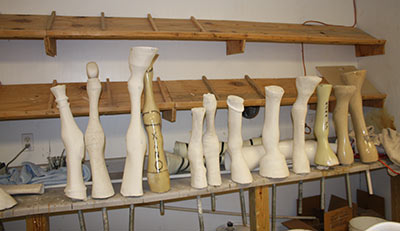
A Detailed Process
Making a prosthetic limb or brace for an animal involves a number of steps. Graves relies on the animal’s veterinarian, his own experience and the latest technology.
Ideally, Graves will see the animal in person, but this isn’t always possible, as some of his animal patients are in distant states or even other countries.
The first step is for the veterinarian to make a negative mold of the animal’s leg, using thin fiberglass material. The mold is then sent to Graves, who makes a plaster cast model and uses this to fabricate the brace or device needed.
Using a high-tech, three-dimensional scanner, he scans the model into the computer using a specialized software program that allows him to make angle corrections and weight-bearing modifications. Once this step is complete, he sends the configurations to a computerized machine that carves the modified leg model out of urethane foam. Graves uses that model to make the actual device. It often takes a month or longer to build one, and in many cases, he ends up making several in an effort to get the best fit.
Depending on the particular prosthetic or brace, some have two parts that are attached to the limb with straps. Others are designed to slip over the residual limb, the correct terminology for “stump.”
Some of the padding and epoxy resin are the very same materials used in human orthotics, but obviously, they must be of a greater density to support a horse’s weight.
The fitting procedure is crucial.
“It requires a lot of dedication. If the owner follows my instructions for getting the animal to accept the device, we have a high success rate,” Graves notes. “It doesn’t work if you just put it on the animal and leave it.”
For at least seven days, the owner puts the device on the animal’s leg for two hours at the most, then takes it off for two hours, except for at night. After that first week, the wear time gradually extends. For example, the animal may wear it for 2 1/2 hours and have it off for 1 1/2 hours at a time. The process, which is specific to each individual animal, continues over time until the animal adjusts to wearing the device as long as needed.
“It’s a little bit like a woman putting on high heels for the first time because it alters the anatomy,” Graves explains. “When you put a brace or prosthesis on an animal, it’s applying new pressure in different areas. The animal couldn’t tolerate that if you just put it on and left it. They have to gradually adjust.”
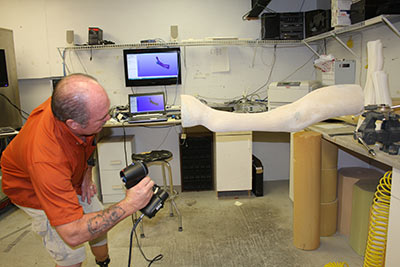
Human & Animal Clients
Today, Graves’ company continues to cater primarily to human clients, but for Graves himself, his efforts are mostly dedicated to his four-legged clientele. He’s found one distinct difference between the two.
“Most human amputees are angry about what’s happened to them,” he notes. “When I meet with them as a practitioner, one of the first things you have to do is listen to them talk about what’s brought them to this point. But with an animal, the horse or dog doesn’t have emotion about the situation. You have to try to find out how the situation is causing them discomfort.”
Graves will only work on cases with a veterinarian.
“I’m not a veterinarian and don’t try to be,” he states. “I won’t work without one; it’s crucial to have their input. They’re the ultimate health care provider for the animal, so they have a lead role. I consider my role as a supportive role to achieve the ultimate end result, which is to support an injured joint or leg and get the animal walking and comfortable.”
Not every animal is a good candidate for a prosthetic or brace. Plus, the animal’s caretaker must be committed to the extra time and effort required.
“There have been cases where I’ve had to tell owners it’s not going to work. I won’t take on a case if I feel I can’t make a difference and help the animal or if the person just wants to turn the horse out to pasture. The person has to be prepared for long-term attentive care,” notes Graves.
The owner also has to realize it’s not a “one-time fix.” A brace or prosthetic can run anywhere from a few hundred to several thousand dollars, and the animal will need more than one, because it will wear out over time or the animal, if young, will grow out of it.
One success story is Mercedes. After shattering her knee and upper cannon bone running and playing in the pasture, the then 11-year-old Arabian mare had only a 30 percent chance of survival. Owner Phil Yarbrough of Auburn, Georgia, sought out the best veterinarians available at the veterinary teaching hospital at the University of Georgia. Lead by Randy Eggleston, DVM, the surgical team inserted titanium plates and fused the leg. The game mare was in and out of the hospital for a year, and the plates were later removed because of infection.
“She had a total of five fractures in that leg,” recalls Yarbrough, who discovered Graves while desperately searching for some sort of support brace. “I don’t know if God led me there or what, but I found his website and told one of the surgeons at UGA about him. That vet contacted Ronnie, and he’s made several braces for her because of how her leg has changed over time. Now she can canter with that brace on.
“Ronnie loves animals and truly cares. He came up here twice to make casts of her leg himself to make the brace,” adds Yarbrough. “He’s her savior; there’s no two ways about it.”
Learn More
(352) 603-4249

